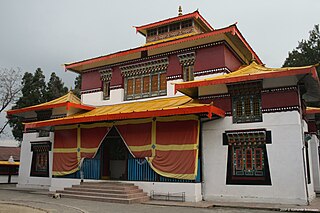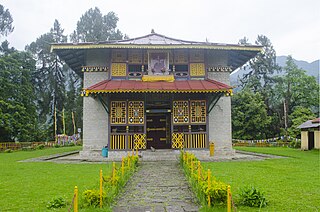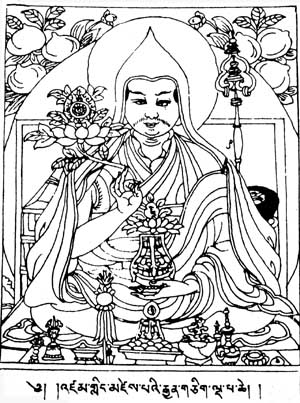The Drukpa or Drukpa Kagyu lineage, sometimes called Dugpa in older sources, is a branch of the Kagyu school of Tibetan Buddhism. The Kagyu school is one of the Sarma or "New Translation" schools of Tibetan Buddhism. The Drukpa lineage was founded in the Tsang region of Tibet by Tsangpa Gyare (1161–1211), and later became influential in Ladakh and Bhutan. It is one of several lineages known as "Red Hat sects".

Pelling is a hill station in Gyalshing district of Sikkim, India. Pelling is nestled at an altitude of 2,150 m (7,200 feet). The town is located at a distance of 10 km from Gyalshing city, the district headquarters and 131 km from Gangtok. A regular bus service connects the two towns. However, with the influx of tourists, the region is undergoing a metamorphosis, with the roads being repaired and hotels being set up.

Khecheopalri Lake, originally known as Kha-Chot-Palri, is a lake located near Khecheopalri village, 147 kilometres (91 mi) west of Gangtok in the West Sikkim district of the Northeastern Indian state of Sikkim.

The Enchey Monastery was established in 1909 above Gangtok, the capital city of Sikkim in the Northeastern Indian state. It belongs to the Nyingma order of Vajrayana Buddhism. The monastery built around the then small hamlet of Gangtok became a religious centre. The location was blessed by Lama Drupthob Karpo, a renowned exponent of tantric (adept) art in Buddhism with flying powers; initially a small Gompa was established by him after he flew from Maenam Hill in South Sikkim to this site. The literal meaning of Enchey Monastery is the "Solitary Monastery". Its sacredness is attributed to the belief that Khangchendzonga and Yabdean – the protecting deities – reside in this monastery. As, according to a legend, Guru Padmasambhava had subdued the spirits of the Khangchendzonga, Yabdean and Mahākāla here. In view of this legend, the religious significance of Enchey Monastery is deeply ingrained in every household in Gangtok. It is also believed that these powerful deities always fulfil the wishes of the devotees.

Yuksom is a historical town in Geyzing subdivision of West Sikkim district in the Northeast Indian state of Sikkim. It was the first capital of Kingdom of Sikkim established in 1642 AD by Phuntsog Namgyal who was the first Chogyal of Sikkim. The coronation site of the first monarch of Sikkim is known as the "Throne of Norbugang". Yuksom is where there is the Norbugang Chorten near the Norbugang throne, the place Namgyal was crowned and several monasteries and a lake. The dynastic rule of the Chogyals lasted for 333 years.

Rabdentse was the second capital of the former Kingdom of Sikkim from 1670 to 1814. The capital city was destroyed by the invading Gurkha army and only the ruins of the palace and the chortens are seen here now. However, the ruins of this city are seen close to Pelling and in West Sikkim district in the Northeastern Indian state of present-day Sikkim; Pemayangtse Monastery is one of the oldest monasteries in Sikkim which is close to the ruins. From the vantage point of this former capital, superb views of the Khanchendzonga ranges can be witnessed. This monument has been declared as of national importance by the Archaeological Survey of India. It was first established in 1670 by the 2nd Chogyal Tensung Namgyal son of the 1st Chogyal Phuntsog Namgyal by shifting from the first capital of Yuksom that was consecrated in 1642.

In religion and spirituality, a pilgrimage is a long journey or search of great moral significance. Sometimes, it is a journey to a sacred place or to a shrine of importance to a person's beliefs and faith. Members of every major religion participate in pilgrimages. A person who makes such a journey is called a pilgrim.
Ganden Choeling Nunnery or Geden Chöling is a Tibetan Buddhist vihara for Buddhist nuns in Dharamshala, India. It is near the monastery in which the 14th Dalai Lama resides.
The name Karma Chagme refers to a 17th-century Tibetan Buddhist (Vajrayāna) lama and to the tülku lineage which he initiated. Including the first, seven Karma Chagme tülkus have been recognized. The Neydo Kagyu sub-school of the Karma Kagyu was established by the first Karma Chagme, Rāga Asya.

The Pemayangtse Monastery is a Buddhist monastery in Pemayangtse, near Pelling in the northeastern Indian state of Sikkim, located 110 km west of Gangtok. Planned, designed and founded by Lama Lhatsun Chempo in 1647, it is one of the oldest and premier monasteries of Sikkim, also the most famous in Sikkim. Originally started as a small Lhakhang, it was subsequently enlarged during the reign of the third Chogyal Chakdor Namgyal and Khenchen Rolpai Dorjee in the year 1705 and consecrated by the third Lhatsun Chenpo Dzogchen Jigme Pawo in the year 1710 C.E. The monastery follows the Nyingma Order of Tibetan Buddhism and controls all other monasteries of that Order in Sikkim. The monks of this monastery are normally chosen from the Bhutias of Sikkim.

Gemur Monastery is a Buddhist gompa, above the village of Gemur, Lahaul and Spiti district, Himachal Pradesh, northern India. The monastery dates from the first half of the 17th century.

Tashiding Monastery is a Buddhist monastery of the Nyingma sect of Tibetan Buddhism in Western Sikkim, northeastern India, which is the most sacred and holiest monasteries in Sikkim. It is described as the "Heart of Sikkim/Denzong", citing to its importance of religious sacredness. It is located on top of the hill rising between the Rathong chu and the Rangeet River, 40 kilometres (25 mi) from Gyalshing and 19 kilometres (12 mi) to the south east of Yuksam. The annual festival of Bumchu, meaning ~Holy water~ takes place on the 14th and 15th of the 1st month of Tibetan lunar calendar, often around the months of February and March. The festival is believed to predict the upcoming forecasts and events for Sikkim in the coming year. Undoubtedly, one of the most important and holiest festivals for all the Buddhists in Sikkim and around, it also provides for a perfect platform for all those Non-Buddhists who seek a deeper insight into Buddhism and its religious customs, beliefs and rituals. History of the Festival- Somewhere between 755 and 804 CE in Tibet under the reign of King Trisong Deutsen. It was under his rule that Guru Padmasambhava when invited to Tibet performed a holy sadhana and consecrated the land with water from his SACRED VASE, which was then later concealed as a hidden treasure in his most blessed place, the Tashiding Monastery in Sikkim. Somewhere around 17th century, the vase was again discovered by one of the reincarnations of Padmasambhava and it is since that time, this festival again resumed with all its glory and splendour in the hidden and blessed land of Sikkim/Beyul Demozong. Tashiding is the nearest town to the Tashiding Monastery (Gompa)

Dubdi Monastery, occasionally called Yuksom Monastery, is a Buddhist monastery of the Nyingma sect of Tibetan Buddhism near Yuksom, in the Geyzing subdivision of West Sikkim district, in eastern India.

Hanle Monastery is a 17th-century gompa of the Drukpa Lineage of the Kagyu school of Tibetan Buddhism located in the Hanle Valley, Leh district, Ladakh, India on an old branch of the ancient Ladakh-Tibet trade route. The valley is home to about a thousand people, with about 300 people living in Hanle village. The monastery is home to about ten monks while another 33 or so come regularly for prayers. It is only 19 kilometres (12 mi) from the disputed frontier between India and Chinese-controlled Tibet. It is 255 km southeast of Leh, 208 km southeast of Upshi & 75 km southeast of Nyoma.

Buddhism in the Himachal Pradesh state of India of has been a long-recorded practice. The spread of Buddhism in the region has occurred intermediately throughout its history. Starting in the 3rd century BCE, Buddhism was propagated by the Maurya Empire under the reign of Ashoka. The region would remain an important center for Buddhism under the Kushan Empire and its vassals. Over the centuries the following of Buddhism has greatly fluctuated. Yet by experiencing revivals and migrations, Buddhism continued to be rooted in the region, particularly in the Lahaul, Spiti and Kinnaur valleys.

The Norbugang Chorten is a stupa situated in the Geyzing subdivision of West Sikkim district in the Indian State of Sikkim. It was erected following the crowning of the first Chogyal of Sikkim in 1642 at Narbugong Coronation Throne near Yuksom. A holy lake known as Kuthok Lake, a serene lake, is also linked to the historicity of the place. The Chorten was the place where Lama Lhutsun Chempo created the time capsule by burying all the gifts to mark the occasion.

The Dual System of Government is the traditional diarchal political system of Tibetan peoples whereby the Desi coexists with the spiritual authority of the realm, usually unified under a third single ruler. The actual distribution of power between institutions varied over time and location. The Tibetan term Cho-sid-nyi literally means "both Dharma and temporal," but may also be translated as "dual system of religion and politics."

Ging Gompa is a Buddhist monastery in Darjeeling, West Bengal, India. The monastery is located in Ging, about 10 km (6.2 mi) from Darjeeling. It is one of the oldest monasteries in Darjeeling and subscribes to the Nyingmapa tradition of Tibetan Buddhism. On historical grounds, the monastery is still under the administrative control of the Government of Sikkim.
Rani Dhunga, originally known as Sita Paila, is a huge rocky outcrop considered to be holy, in the Himalayas 6 km to the north-east of Pelling town, Sikkim, India, at an altitude of 2680m.
Khandu Wangchuk Bhutia is an India thangka painter from the Sikkim, known for his exquisite creative works in the Thangka style of painting. Thangka is a Tibetan Buddhist painting on cotton, silk appliqué, usually depicting a Buddhist deity, scene, or mandala. Thangkas are traditionally kept unframed and rolled up when not on display, mounted on a textile backing somewhat in the style of Chinese scroll paintings, with a further silk cover on the front. Khandu Wangchuk Bhutia hails from Sakyong in West Sikkim and had his formal education from Government Senior Secondary School in Pelling and at Senior Secondary School at Namchi. After his formal education, he was ordained into monastic life at the Pemayangtse Monastery. In the monastery, he took up Thangka painting as a profession. He trained in Thangka painting under several renowned thangka painters like Dungzin Rimpoche, late Jigme Wangchuk Lama, late Phuntsok Sangpo and late Zapa Acho.





















